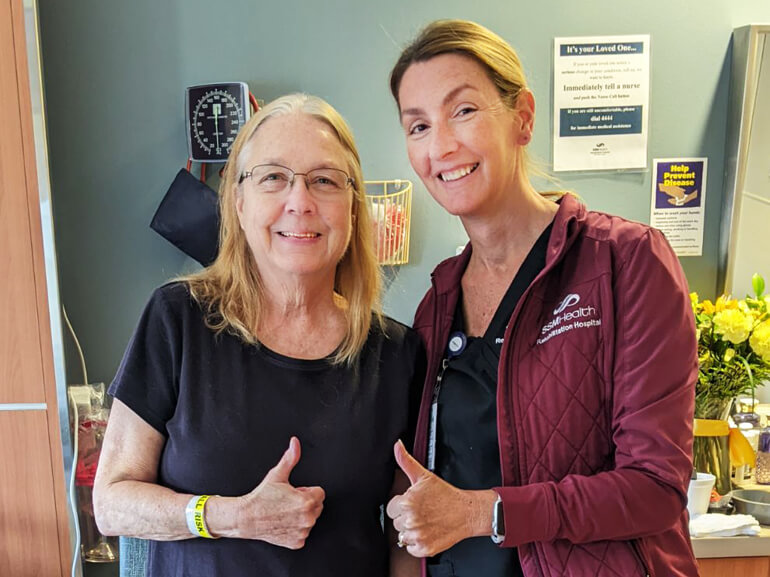Cindy's story

Cindy Mohrmann of Fenton, Missouri was planting sunflowers in her garden on a beautiful summer’s day when she noticed that her feet were feeling numb. A grandmother of five who also works full-time in customer service, Cindy likes staying busy with gardening, reading, swimming and spending time with her family and her cat, Molly.
Over the next few days, Cindy noticed that the numbness in her feet was worsening, gradually moving up her legs, which also began to feel weak. She began to experience difficulty walking and before long, the numbness had moved to her arms and hands, leading her to drop items that she was holding. When Cindy’s numbness and weakness got to the point where she could no longer walk, she called 911.
Rushed by ambulance to SSM Health St. Clare Hospital, Cindy underwent extensive neurological testing, including an MRI and a lumbar puncture, also known as a spinal tap, which is a test used to diagnose certain health conditions. Cindy was diagnosed with Guillain-Barré syndrome (GBS), a rare neurological disorder in which the body's immune system attacks the nerves, resulting in weakness and paralysis.
Unable to walk or use her arms and hands, Cindy was given five doses of intravenous immunoglobulin therapy in the hospital to help decrease her body’s autoimmune response and assist with recovery. Once she was medically stable, her physicians recommended an intensive inpatient rehabilitation program to help her regain her mobility and independence.
Cindy transferred to SSM Health Rehabilitation Hospital – Richmond Heights motivated to begin her recovery. Her physician-led team of rehabilitation specialists, including physical and occupational therapists, worked with Cindy on a plan to help her reach her goals of being able to return home independently and go back to work.
In physical therapy, Cindy’s team focused on improving her balance and leg strength to help her begin walking again. Cindy initially required significant help just to stand up. She was able to walk for only 10 feet while using a walker and the assistance of her therapists to take steps while remaining upright. To aid in her return to walking, Cindy’s physical therapists utilized an exoskeleton, which is a wearable robotic suit that provides power to the legs to help patients learn to stand and walk again. Initially, Cindy relied on the exoskeleton to do most of the work, with the goal of reducing reliance on the device to help her take steps independently. Therapists also guided her in kneeling exercises to improve her core strength and stability and balance exercises, including side stepping and walking backwards, to help with coordination and leg strength. Cindy’s therapists noted that she was so driven during her time in rehab that she asked for exercises to work on in her room during the evenings and weekends.
Occupational therapists worked with Cindy on becoming independent and while completing her personal care activities, including showering, dressing, grooming and using the bathroom. Initially, she required significant assistance for all activities. Cindy and her team focused on building up her strength and endurance so that she could stand safely while performing her personal care. To help improve her hand strength and fine motor skills so that she could hold utensils and other items, Cindy worked with theraputty, which is a strong putty-like material that can be stretched, pinched, squeezed and kneaded. Like in physical therapy, Cindy requested extra “homework” in the form of handwriting practice.
Because it can be difficult to see progress day-to-day while undergoing intensive rehabilitation, Cindy said she appreciated her rehab team’s ability to help her see the big picture. “Hearing people say I was doing great helped me keep going, because I didn’t always see it,” she added. Cindy was also an active participant in occupational group therapy, where she found a supportive community of fellow patients sharing in the rehab experience with her.
Cindy’s family and friends came out in force to support her throughout her experience. “My sister has been my biggest cheerleader,” Cindy said, adding that her sister not only has supported her throughout the rehab process, but has also been taking care of Molly. Cindy’s friends also chipped in by stopping at her home to water her plants so they would be beautiful and thriving when she returned home.
After a month-and-a-half at SSM Health Rehabilitation Hospital – Richmond Heights, Cindy had made remarkable progress. Not only was she able to transfer and walk short distances independently, but she was able to climb stairs with assistance only needed for balancing. Cindy demonstrated independence with all of her personal care tasks.
Because Cindy was planning to spend a few weeks at her sister’s home to help ease the transition from rehab to home, Cindy’s sister attended several family training sessions to ensure she was comfortable with providing assistance at time of discharge.
At the end of her time in rehab, Cindy spent some time reflecting on her stay and compiled a list she titled, “Things I could not do when I arrived here.” Items on the list included standing, walking, getting dressed, writing, brushing her hair, bend her feet or her toes, cutting up food and putting medication in her mouth. At the end of her list, Cindy wrote triumphantly, “I can now do all of the above.”
At discharge, Cindy said she was most looking forward to reuniting with her cat and spending time with her family, adding that she was also excited to return to work. Cindy planned to continue with intensive therapy at the SSM Health Day Institute in Arnold to build on her progress and reach her long-term goals for recovery.
To anyone who is facing a difficult recovery or any kind of challenging time, Cindy offers the following advice: “If you dig deep, you’d be surprised at what you can do.”